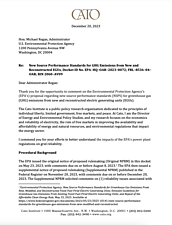The Cato Institute is a public policy research organization dedicated to the principles of individual liberty, limited government, free markets, and peace. At Cato, I am the Director of Energy and Environmental Policy Studies, and my research focuses on the economics and reliability of electricity, the role of free markets in improving the availability and affordability of energy and natural resources, and environmental regulations that impact the energy sector.
I commend you for your efforts to better understand the impacts of the EPA’s power plant regulations on grid reliability.
Procedural Background
The EPA issued the original notice of proposed rulemaking (Original NPRM) in this docket on May 23, 2023, with comments due on or before August 8, 2023. The EPA then issued a supplemental notice of proposed rulemaking (Supplemental NPRM) published in the Federal Register on November 20, 2023, with comments due on or before December 20, 2023. The Supplemental NPRM solicited comments on (1) reliability issues associated with the Original NPRM and (2) EPA’s Initial Regulatory Flexibility Analysis (IRFA), which EPA undertook after publishing the Original NPRM.
Summary
The instant comment responds to (1) and (2) above and requests a new Supplemental NPRM on the impact of the Original NPRM on the cost of electricity. The EPA’s choice of low-GHG hydrogen and carbon capture and storage/sequestration (CCS) as the best system of emission reduction (BSER) was arbitrary, capricious, and unsupported by the available data when it was proposed. Recent developments have further eroded the justification for the EPA’s proposed BSER and raised additional concerns regarding whether the EPA has adequately assessed the proposal’s impacts on the cost and reliability of electricity.
I urge the EPA to reconsider its proposal and institute a new rulemaking founded on technologies that have been adequately demonstrated. It is encouraging that the EPA recognizes the wider reliability issues associated with the Original NPRM. In the Supplemental NPRM, EPA stated: “Because mechanisms to address reliability concerns are relevant to many entities in the electricity sector, we are more broadly soliciting comment on reliability issues.”
However, the issues with the Original NPRM are so numerous and complicated that the best path forward is for the EPA to go back to the drawing board. At the bare minimum, the EPA should improve its rulemaking by offering an objective, unbiased assessment of the reliability and cost impacts of the Original NPRM. To that end, the EPA should issue a new supplemental NPRM seeking comment on the impact of the Original NPRM on the cost of electricity. The EPA should also update its resource adequacy analysis considering the financing difficulties facing many new EGUs driven by higher interest rates.


